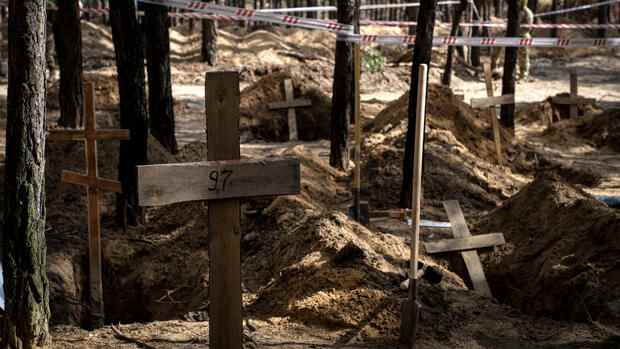Most of the graves in Izyum are only inscribed with numbers.
(Photo: dpa)
Vienna Bucha and Irpin, where hundreds of Ukrainians were murdered, raped and tortured, have become a symbol of Russia’s reign of terror. President Zelensky immediately drew similar parallels after the authorities found the graves of 445 people in the recently liberated city of Izyum: “Bucha, Mariupol and now unfortunately also Izyum,” he said in his video address on Thursday. “Russia leaves death everywhere.”
The images of mounds of earth marked with simple wooden crosses in the middle of trees give an idea of the human suffering that Russia’s invasion brought with it. According to the Ukrainian authorities, most of the graves are individual graves, most of which are inscribed with numbers instead of family names. A mass grave is known to contain the remains of about two dozen fallen Ukrainian soldiers.
The circumstances under which the people, who otherwise mostly came from the local population, died are only partially known. The examination of the burial place by coroners and police specialists has only just begun.
Kharkiv Oblast’s chief investigator said some of the victims had been shot dead, while others were probably indirectly killed in the fighting. On Friday evening, Dmitro Lubinets, the Ukrainian parliament’s human rights ombudsman, said the bodies of 20 soldiers had been found, first tortured and then shot. The suspected prisoners of war had their hands tied behind their backs.
Top jobs of the day
Find the best jobs now and
be notified by email.
Ukrainian Missing Persons Commissioner Oleh Kotenko cautiously said: “I think the majority died during the shelling of the city, we realized that from the data: people were killed when the Russians shelled the city with artillery.” This is shown not only by the available death books, but also by the fact that the Ukrainian authorities became aware of the graves through a video published by the Russians in the spring. The first battle for Izyum had begun on March 3rd. As elsewhere, the occupiers paid little heed to civilian infrastructure or even deliberately targeted it.
Evidence of torture found
What is clear, however, is that the tomb is just one particularly large one among many. Elsewhere in the Liberated Area of Kharkiv Oblast, authorities have found 50 bodies of people who died violently. The Ukrainian police also report that 10 interrogation rooms have been found in the region so far, in which torture was also used. In the past week, 204 cases of possible war crimes have been initiated.
For Oleksandra Romantsova, this preliminary information coincides with experiences in other regions such as Kyiv or Sumi. “Every time the Russians occupied territory, they killed people. For many reasons – because they didn’t like someone, because they were in a bad mood or because they were drunk, because of some order,” explains the head of the Center for Civil Rights in Kyiv.
Your non-governmental organization has been meticulously documenting suspected war crimes since February 24, including in the occupied territories. 19,282 cases have accumulated as of Friday, about two-thirds of them in the Luhansk, Donetsk, Kharkiv and Kherson regions, all of which are at least partially occupied.
The primary sources are the accounts of displaced people, which now have to be investigated on the ground in the liberated areas. Romantsova expects another wave of investigations once people return to their hometowns or gain access to Ukrainian investigators in liberated villages. “What we see now is just the beginning.”
>> Read here: Russia is now targeting Ukrainian infrastructure
However, Romantsova points out that the Ukrainian authorities lack the specialists to conduct the investigations. “We need international help for this.” Ukraine also receives this: According to a report by CNN, the United Nations have decided to send a team to Izyum. The International Criminal Court in The Hague has also been investigating war crimes in the country since March.
As long as no more details are known from Izyum, the Kiev native will only cautiously comment on the comparisons with Bucha. Oleh Kotenko had rejected this. “I don’t want to call this a boucha,” he said. People were buried in a more civilized way. For Romantsova, on the other hand, the questions are in the foreground: “Did the Russians shoot at schools with artillery, as they did in Bucha, and use people as human shields? Or were there certain rules in Izyum despite the occupation?” She hasn’t given up hope that the Russians are also capable of learning processes. However, she is not very optimistic.
More: Russian withdrawal: “That does not speak for a high morale”
